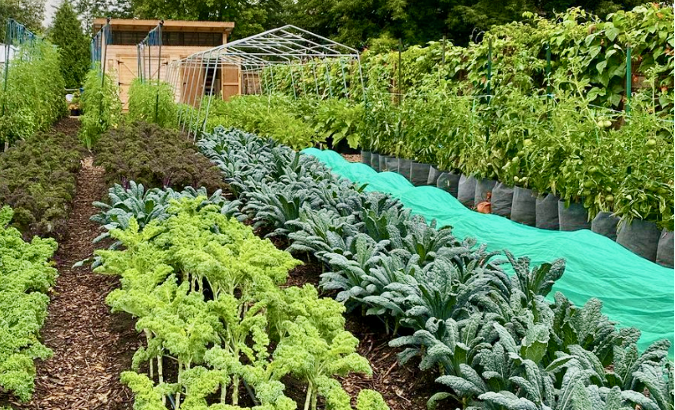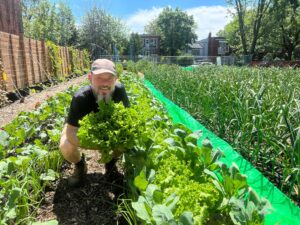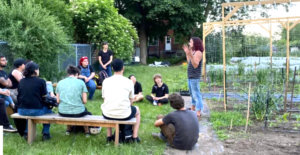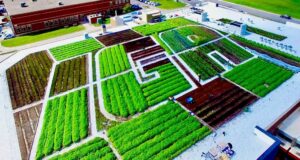By Jesse Correll, guest editor
Urban agriculture in Montréal has a rich history of growing from the ground up. From its roots in traditional farming, it has adapted to the limited space and resources in the urban environment, becoming increasingly important to the communities around it. According to architects Vikram Bhatt and Leila Marie Farah, by 2013, “Montréal emerged as a unique habitat for urban agriculture initiatives, and has become a leader in North America, with an estimated 42% of its residents actively involved.”
In 2017, Montréal architect Réal Migneault decided he wanted to do more for his community. With 20 years of gardening experience, he believed he could help fight food insecurity. He dropped everything and went back to school to learn agriculture.
Shortly after, Migneault began his own garden project in front of his house. Soon, his family of four was nearly self-sufficient from the vegetables he grew. Tasting this success, he expanded his project. “At one point the kids were all out of the home and I realized that I had too much food, too many things coming from the garden, and my freezer was still full from the year before,” says Migneault.
He began selling vegetables to his neighbours from his parking space. “It was really successful. I almost became the depanneur of veggies for my neighbours,” says Migneault. This is where his project got its name “La Ferme de Rue” or, in English, “The Street Farm.”
As the demand for his produce grew, Migneault teamed up with a local church, Sanctuaire Saint-Jude, using their previously unkempt lawn space to expand his garden. This let Migneault continue to support those around him. “We are defining ourselves by the impact that we have on our community, so we’re giving away about 15 percent of our production to a food security organization in the neighbourhood,” he says.
According to the City of Boston, “Urban farming gives residents better access to fresh, healthy, and affordable food. It also cuts down on transportation costs and carbon emissions.” These benefits make it extremely attractive to those who are having trouble putting food on the table as well as those seeking to make a difference in their communities.
CultivAction, a two-year-old urban agriculture solidarity co-operative in Montréal, is another such organization. “We supply over 5000 pounds of food every year to community organizations,” says Caleb Woolcott, who’s been with the co-op since its inception. With agriculture projects on Concordia University’s Loyola campus as well as in Senneville in Montréal’s West Island, the group considers itself both student and community based.

Woolcott and other members of the cooperative show off a successful harvest. Photo: Coop CultivAction.
CultivAction recently began receiving a fee levy from Concordia University. The fee takes only a couple of cents from each student’s tuition but covers CultivAction’s entire budget. “Because we’re able to get this budget and we’re growing our own food, we are able to multiply the impact of what a student would be able to buy with that money,” says Woolcott. As a result, more food is produced than the students would have gotten if they’d spent their money at the grocery store instead. Among their services, the group offers a pay-what-you-can market for Concordia students and others in need.
Besides their charitable donations of fresh food, both La Ferme de Rue and CultivAction prioritize education. CultivAction offers opportunities to Concordia students, while La Ferme de Rue teaches children from neighbouring schools who visit on field trips. Both offer courses that teach about the ideals and methods of urban agriculture and include hands-on training. In return, the organizations get extensive help from volunteers, many of whom they eventually recruit as full-time employees.
According to a review by Cornell researchers Alex Russ and Madeline Gaus, these types of programs foster “competencies that can contribute to youth’s future civic engagement. These competencies range from understanding of inequality, to leadership and teamwork, to a sense of becoming community change agents.” Strong community ties and urban agriculture go hand-in-hand.
Along with these more abstract educational rewards, students of urban agriculture learn that it’s a very efficient type of farming. “Urban agriculture is a lot more of an intensive type of agriculture, you work a smaller piece of land using every square foot, every square inch, to the best of its ability and within its capacity to get food,” says Jackie Martin, Concordia’s Urban Agriculture & Biodiversity Coordinator.
According to Martin, however, urban agriculture does face some adversities, especially in Montréal. For one, the changing climate has caused problems like the summer weather being unpredictably very rainy or very dry. “The winter freeze is not lasting as long, there’s new pests that have moved further north, such as the Japanese beetle – it has been in North America the last 70 years but really moved into Montréal like 10 years ago,” adds Martin.
Despite these challenges, Montréal’s urban agriculture has seen great success, in part due to people’s ability to adapt. “You have to learn new skills. Since there’s new bugs, you can’t really rely on the [knowledge of the] farmer who’s been gardening in the area for a long time,” says Martin. The multiculturalism in Montréal allows for methods with roots in different cultures to flourish together and build more successful farms and garden projects.
La Ferme de Rue experienced these benefits when they began working with the church. Sanctuaire Saint-Jude church had strong ties to the neighbourhood’s immigrant community, providing many with food and temporary housing. Since Migneault partnered with the church, many of these immigrants became his customers and some even began working for the project.
“You have to be creative and be able to adjust the business model. I’m not afraid I will have to scale down. Instead, our business model is relying on social impact, and we are working on getting more private support.” says Migneault. He hopes to continue to expand by maximizing production and efficiency at their current locations and eventually seeking new acquisitions.
La Ferme de Rue has even teamed up with restaurants and grocery stores like IGA. They helped build the familiar IGA rooftop garden with the letters cut into the crops for travelers to see as they fly into Montréal’s YUL airport.
Montréal’s urban agriculture scene reflects a thriving community effort to address food insecurity and empower residents. As the city continues to adapt to challenges such as climate change and resource constraints, the future of urban agriculture in Montréal holds promise, driven by innovation, community collaboration, and a commitment to local food resilience.
Feature image: Rows of kale. Photo: La Ferme de Rue.







